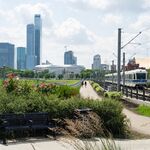IanO
Superstar
^that they do and I am a massive HSR guy, but even in Europe and Japan those speeds are not as common or sustained as much as folks are led to believe given the number of cities and other restrictions; I'd bet that it is 2/3 of that.
It is both vital and feasible. Alberta is growing up and I suspect we'll all be discussing this much more in the coming years.it is interesting to see all the talk about how vital it would be to have train stations downtown and virtually none on whether a train itself is really vital or not…
perhaps… hopefully not in the way we’re discussing valleyline lrt or the way california is discussing their hsr. in the meantime, assuming edmonton and calgary both grow to 2 million, is there a 300 km corridor anywhere in the world successfully linking 2 cities of 2 million (and nothing outside of those 2 cities although mid point stops are okay) with hsr?It is both vital and feasible. Alberta is growing up and I suspect we'll all be discussing this much more in the coming years.
In my opinion, looking at our downtown and airport we need things like more head offices here, not just a faster way to get to another city that has long ago figured out it is better not to be a branch plant city.What makes the corridor attractive is that it is one jurisdiction, relatively easy geography and a fairly reasonable distance between two very interconnected cities. What you see as a weakness (two large cities with virtually nothing else around but each other) is actually a strength. Edmonton needs Calgary and vice versa because there are no other dance partners around. HSR will create an economic hub of 4 million people rather than two economic hubs of 2 million people. That's what makes it vital. And it is far more feasible, and closer to reality, than most Albertans realize.
So what you are saying is, providing less public transportation/inter city connectivity and maintaining smaller economic hubs is the way to attract head offices to Edmonton. Bizarre approach.In my opinion, looking at our downtown and airport we need things like more head offices here, not just a faster way to get to another city that has long ago figured out it is better not to be a branch plant city.
It would be prudent to incorporate an HSR corridor on a new high level bridge. Getting it to terminate within the Financial district is logical but I’m not exactly sure how we would go about doing that.If we are going to spend Billions on HSR between Edmonton and Calgary I would hope they could find a way to get the train to a downtown station. If they couldn't then at least needs to be a good LRT connection to the line if it terminated in Old Strathcona.
It sadly can't support that anymore; the city hired a company to see if it could support LRT (before the centre line was scrapped), and they found that the beams have lost around 50% of their density on average, so it couldn't even support LRT without significant strengthening.The High Level Bridge could be used for regular intercity rail
The High Level Bridge could be used for regular intercity rail (which is what we should be talking about before we even dream of HSR). But if we are to contemplate a HSR alignment, it would most likely be a terminus station in Old Strathcona in the short- to medium-term, and then a series of tunnels and a new bridge to downtown in the long-term.
The long term plans (by 2065) are for bus rapid route B1 (castle downs - century park) to have an exclusive river crossing, and B2 (WEM/Misericordia - Bonnie Doon) to to be *considered* for a river crossing (they cite uncertainty because of financial, social, and environmental considerations which are for some reason not mentioned in B1's case). Perhaps one of these crossings could be expedited if it could also accomodate rail traffic?The High Level Bridge is not able to support intercity rail of any kind, including HSR. The terminus has to be downtown so a new bridge would be the way forward. The timing could be good, with both the CoE and likely HSR proponents need to span the river...sounds like a great cost share opportunity to me.
I gladly confess my ignorance in all things high speed rail, but questions arise. Is there actually a need for it? I mean, it would serve an extremely small client base and even then would still need to compete with air. Why concentrate on a 19th century technology? Are people actually requiring the need to commute Edmonton to Calgary and back when a zoom meeting will suffice? Seems to be an awfully expensive technology to try to replace air travel. We don't even know how autonomous vehicles in the very near future will affect the equation. I know that there are a few HSR fans on this forum but hey, make your case.




